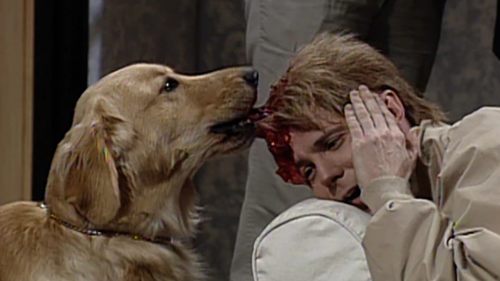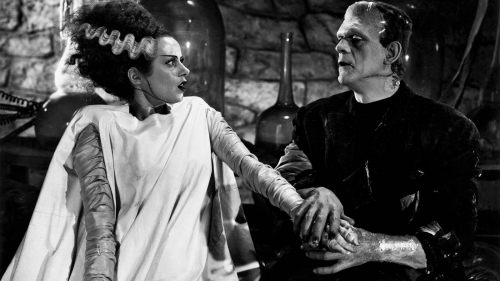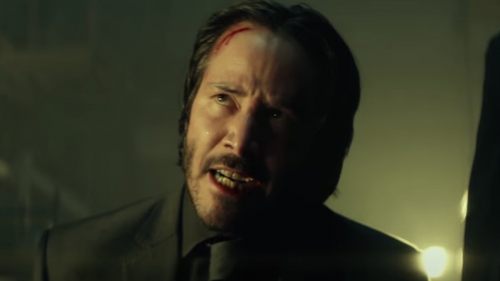Serial Killer Films Do More Than Entertain
A Ted Bundy double-header has come down the pike in the form of Netflix documentary Conversations with a Killer: The Ted Bundy Tapes and a feature film, Extremely Wicked, Shockingly Evil and Vile (both of which, curiously enough, come to us from director Joe Berlinger), and with their arrival certain conversations are bound to take place. True crime fans are thrilled, while detractors tend to take on a moralizing stance, insisting that nothing else could possibly be learned by looking back at cases like Bundy's, and that to look back is to give a glamorous spotlight to murders. Sometimes, that rings true. In general, though, there are nuances to the analysis (academic or not) of mass murderers and the culture surrounding them.
When we unpack the why and how of the crimes these people have committed, the conversation can and must include the cultural impact of the Mansons, the Bundys, and the Nightstalkers. It's everywhere: years after their crimes took place, these jabronis appear on t-shirts, worn by the Edgiest of Edgebros in an apparent contest to see who can be the most callous towards actual murder victims. Similarly (and to Netflix's great dismay), a massive vomitus of Ted Bundy thirst tweets spilled forth on social media in the wake of Conversations with a Killer's release. As such, it's a fair caveat to voice concern that when we consume this media - documentaries, crime-centric biopics, books, podcasts - we run the risk of elevating real personas who have killed real people to the same iconic status as the made-up burn victim who slashes made-up teens in their made-up dreams. The trouble, of course, is that the Venn Diagram of horror fans and true crime nerds has a heavy overlap. We have worn paperbacks of Helter Skelter in the same rooms where we display our Friday The 13th box sets and Goblin vinyl collections. Like the horror genre, true crime offers the opportunity to face and deconstruct fears within a controlled, removed environment. When one is fascinated by the pathos behind atrocity and the things that society deems monstrous, it becomes fairly easy to approach fiction and nonfiction with the same zeal.
The same conversation of cultural impact, to the inevitable ire of some, can and must also include the undeniable charm of these criminals. Charles Manson was able to convince an entire group of youths to kill on his behalf. Ted Bundy was able to lure in victims and enjoy a fair amount of privilege within custody due to his infamous charisma: he was able to make his first escape from jail because he was left alone for a fair amount of time, unbound, which (it should go without saying) is not a luxury afforded to many. It's worth asking what systemic biases set him up for success. Richard Ramirez, meanwhile, married one of his many groupies while on death row for thirteen counts of murder and eleven sexual assaults. It's important to note that this part of the conversation is not an endorsement of the crimes themselves. The talk about cultural impact and how these men were able to operate is instead revelatory, not just for the killers, but for society and culture.
We should have to look hard at why these men enjoy the limelight. The Ted Bundy Tapes illuminates this aspect quite clearly: Bundy's manipulative ways were often confused for intelligence, even prompting a judge at his murder trial to proclaim that he would have made a good lawyer. I'm not kidding. His pretty white boy looks were confused for a quiet charm, when Tapes showed him to lose control and become belligerent often, a whore to his own vanity and a true believer of his own lies. Bad documentaries can be harder to watch and deserve to be put on blast, sure enough. But decent ones like Tapes serve to pull back the curtain a little bit more, while giving the victims screen time, tangibility, and most importantly ask, "How did we fail them?"
Serial killers are bad people who have done atrocious things, and those things are often hard to examine. However, collective attempts to safely Other them miss the mark. The usual write-off is, "He's evil, period. A deranged psycho. Could never be me, or anyone I know. Fry him and be done with it." But they are people we know. Some killers live on the fringes of society, sure, but plenty of them are also neatly blended among the innocent and law-abiding. Ann Rule wrote entire books about this. Bundy is the guy next to you at the call center. Gacy is an usher at your local church. They may be outliers in a socio-behavioral sense, but in society? Your local mass murderer lives right down the street, and statistically, he's probably a straight white man. There is value in probing all of this for a greater understanding of this godforsaken hellscape of a planet and how we stay alive and move about in it.
Of course, there's a difference between that examination and glorification. Many factors play into this when the new serial killer film or documentary du jour comes out: is the tone playful, or does it treat the subject matter with gravity? Are the victims given respect, or are they further objectified? Is there a genuine aim to understand the motivations and catalysts that led to these crimes? When addressing the killer's popularity, is the audience put in a position to contemplate, or celebrate? If the film is based upon a book, has the author's ownership of the story been subjugated in favor of the killer? If the killer was a conventionally attractive person, a filmmaker could sexualize them, but should he? Does this film commit the most trendy sin of romanticizing the white male serial killer? These are the elements to poke and prod at. For a good primer on the serial killer profile done right, see Henry: Portrait of a Serial Killer. For a stellar look at the horrifying knowledge that someone known and beloved is a monster, see The Clovehitch Killer (which, while not a biopic by any means, has heavy B.T.K. similarities in its antagonist). For a good dive into the brutal cause-and-effect thrashing that can prompt the vulnerable into killing, watch Charlize Theron turn in a harrowing performance as Aileen Wuornos in Monster. These films do not glorify, they inspect. This is a gentle reminder to stay frosty, and know the difference.
The endeavor to distance ourselves from killers and wash our hands of case after case is tempting, and to be fair, true crime is certainly not for everyone. But one thing rings true of horror fans and true crime enthusiasts alike: gazing into the darkness is not itself an act of endearment. Horror fans in particular should be intimately aware of crappy reactions to the media they consume. How many times have you heard, "What kind of sick person would want to watch something like this?" from someone who just doesn't get the gradations of the genre and its commentary value? If we're going to examine a body of crime, we scrutinze the ugly warts just as thoroughly as we gaze into the kind eyes. We look at the ways in which someone has gone off the deep end, and the ways in which they have effortlessly blended in among us for years. The hard truth is that it's far more complicated than, "This guy is evil, and that's that." Watch these films, and appraise them accordingly. If they screw it up, call them out. But don't condemn these works sight unseen. Many serial killer films have something to say about "them" and "us".
Don't look away.



